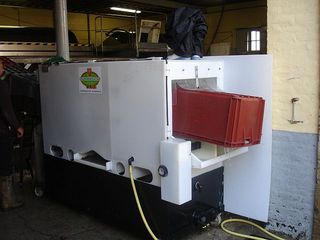Who knows whether it's good luck or Mother Nature balancing out that awfully wet month of August, but for the past few days the weather in Champagne has been just fabulous. Clear blue skies with lots of sunshine and temperatures into the mid - high 20sC ( that's 77 + Fahrenheit) - just perfect for harvesting and the hustle and bustle has continued apace.
In the last blog post we'd been following the harvest up until the time the grapes got back to the pressoir (or pressing hall), so let's see now what happens inside the pressoir.
 First and foremost the grapes have to be weighed and their origin and variety logged.
First and foremost the grapes have to be weighed and their origin and variety logged.
This is mandatory not just to monitor the amount of grapes that has been harvested, of which type and from which vineyard, but also because there are strict rules about how much juice you are allowed to press from a given weight of grapes.
Lots of people will want this information later on, especially the tax man - where there's alcohol involved there's always tax!
The standard unit used for pressing is called a 'marc' which is 4,000 kg (almost 9,000 lbs) and from each marc you're allowed to extract 2,550 litres of juice.
If you do the calculation you can see that, roughly speaking, it takes 1.2 kg of grapes to make one 75cl bottle of champagne.
Anyway, once the grapes are weighed they're loaded into the press in units of a marc at a time
Here's a traditional style press : a circular row of wooden staves bound by several steel bands. The grapes are loaded into the centre, raked over to level the surface and then down comes a flat circular lid forced down by a hydraulic screw.
: a circular row of wooden staves bound by several steel bands. The grapes are loaded into the centre, raked over to level the surface and then down comes a flat circular lid forced down by a hydraulic screw.
As the grapes are crushed, very slowly, the juice flows into a gutter around the base of the press and down a plug hole into a holding container below called a belon.
From the belon the juice (or moût as it's now called) is pumped into resting vats where it spends at least 12 hours so as to allow the sediment to settle - all those bits of stalk and leaf, mud and dust that inevitably find their way into the press.
The results you get from a traditional press are fine, but these days more and more champagne makers are switching to modern horizontal, cylindrical presses like this one which are more precise, easier to load and unload and easier to clean .
.
These presses operate either with two plates that are screwed in from either side to compress the grapes or with an inflatable bag of air that crushes the grapes as it is inflated . Not so quaint to look at as the old-style presses, but technologically more advanced. Why doesn't everyone use them ? Because they cost a fortune.
Then the empty cases the grapes came in are washed in a special 'case washing machine' ( yes such things do exist) to be sent back to the vineyards.


The floor of the press house is washed down and swept and it's time to start the process all over again until all the grapes have been harvested and have been safely pressed.
This year quite a large proportion of the grapes are not fit to use because of the rot on the vines. In places I've heard that as much as 40% of the crop is being discarded because of this.
Other places report better fortune with only 10% or so wastage.
In theory the rotten grapes should be sorted either as they are picked, or in the press house before they are pressed. In practice though this is rarely carried out as carefully as it should be.
When asked what the overall quality of this year's harvest is like, a few vignerons are telling me that it's still too soon to tell - more analysis of the juice will be needed before getting a clear picture.
Even more vignerons are telling me it's 'pas terrible'
You might think this means 'Not Bad' but in a strange twist of colloquial French this actually means 'Bloody Awful'
'Go figure' as we might say
More coming soon. Meanwhile if you're a real champagne lover and want to get the full low-down on the harvest and everything else about champagne then take a look at this new and unique on-line champagne course
http://www.madaboutbubbly.com/MeetMONICA.html

